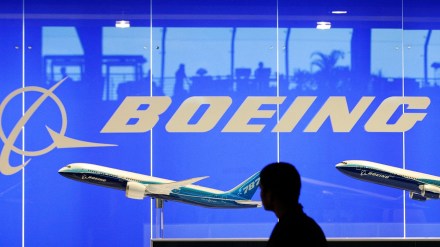For decades, Boeing epitomised aviation excellence, standing as an epitome of reliability and cutting-edge engineering. However, a series of catastrophic failures in recent years has cast a long shadow over the company’s once-sterling reputation. From preventable mechanical errors to tragic crashes, Boeing’s downfall offers a stark lesson in how prioritising profits over product quality and innovation can lead to disastrous consequences.
The Alaska Airlines Incident: A Symbol of Systemic Issues
On January 6, 2024, Alaska Airlines Flight 1282 experienced a harrowing incident that accentuated Boeing’s deepening troubles. As the Boeing 737 Max 9 ascended from Portland, Oregon, a fuselage door plug blew out, causing a violent decompression. Passengers described a terrifying scene as the cabin was filled with a clamorous boom and gale-force winds that ripped headrests from their moorings. Miraculously, there were no fatalities, but the missing bolts that led to the incident highlighted a fundamental failure in Boeing’s manufacturing process.
For a company that once epitomised engineering precision, such a basic oversight was alarming. The missing bolts pointed to broader quality control issues within Boeing, suggesting that the company’s rigorous standards were no longer being met. This incident was not an isolated event but part of a troubling pattern of preventable errors that have plagued Boeing in recent years.
The 737 Max Disasters: A Turning Point
The 737 Max disasters in late 2018 and early 2019 marked a pivotal moment in Boeing’s history. The crashes of Lion Air Flight 610 and Ethiopian Airlines Flight 302, which killed 346 people, were traced back to a critical design flaw in the Manoeuvring Characteristics Augmentation System (MCAS). This software, intended to prevent stalls by automatically adjusting the plane’s nose, malfunctioned due to faulty sensor readings.
Compounding the problem was the fact that pilots were not adequately trained on the MCAS system. In some cases, they were not even aware of its existence. The lack of transparency and insufficient training contributed to the tragedies and led to a global grounding of the 737 Max fleet. These incidents exposed not only technical failings but also significant lapses in Boeing’s safety culture and communication protocols.
The Role of Corporate Culture
The root of Boeing’s problems can be traced back to a seismic shift in its corporate culture following its 1997 merger with McDonnell Douglas. This merger brought in a management philosophy that prioritised cost-cutting and profit maximisation over the engineering-driven culture that had previously defined Boeing.
Under the influence of McDonnell Douglas, Boeing’s leadership increasingly comprised MBAs focused on financial performance rather than engineering excellence. This shift led to outsourcing critical components, reducing the skilled workforce, and moving the corporate headquarters away from its main production facilities. The resulting disconnects between management and engineering teams eroded the company’s ability to maintain its historically high standards.
Outsourcing and Quality Control Issues
One of the most consequential decisions in Boeing’s recent history was the outsourcing of 70 percent of its design and manufacturing processes. This strategy, aimed at cutting costs and securing international orders, backfired hugely. Managing a complex, global supply chain introduced significant quality control challenges, delaying production and increasing costs.
The 787 Dreamliner serves as a case study in the pitfalls of this approach. Initially budgeted at US$8 billion, the project’s costs ballooned to US$32 billion due to numerous production issues. The extensive outsourcing led to a fragmented manufacturing process, resulting in delays and quality problems that tarnished the Dreamliner’s rollout. Specific examples of these issues include the midsection assembly problems in Italy and the fuselage manufacturing delays in Japan.
Stock Buybacks and Short-Term Thinking
Instead of addressing these quality issues and investing in new product development, Boeing opted to spend US$61 billion on stock buybacks between 1998 and 2018. This strategy was designed to boost earnings per share and satisfy shareholders but at the expense of long-term stability and innovation.
This focus on short-term financial gains masked underlying problems but only temporarily. The lack of investment in research and development, combined with deferred maintenance and safety improvements, set the stage for the crises that followed. Boeing’s leadership chose financial engineering over the rigorous engineering that had built its reputation.
The Human Cost
The human cost of Boeing’s decline is stark. The 737 Max crashes alone claimed 346 lives, leaving families devastated and survivors traumatised. Additionally, numerous other preventable incidents have endangered passengers and crew, eroding public trust in Boeing.
These tragedies highlight the critical importance of prioritising safety and quality in aviation. Boeing’s failure to do so has had profound consequences, not only for those directly affected but also for the broader public who rely on the safety of air travel.
Rebuilding Trust and Future Challenges
To regain its former stature, Boeing must undertake significant reforms. This includes reinvesting in engineering excellence, enhancing quality control, and overhauling its corporate culture to prioritise safety and reliability over short-term profits. Boeing faces numerous ongoing and future challenges. Regulatory scrutiny, legal battles, and intense market competition will test the company’s resolve. Rebuilding public trust will require a sustained commitment to transparency and accountability.
The Death of a Giant
Boeing’s fall from grace serves as a powerful reminder of the delicate balance between financial performance and engineering excellence. The company’s shift towards a profit-driven approach compromised its core values, leading to catastrophic failures.
The path forward for Boeing involves a return to its roots: prioritising quality, safety, and innovation to rebuild its reputation and restore public confidence. For now, the sentiment “If it’s Boeing, I ain’t going” captures the wariness of passengers worldwide, reflecting the long road Boeing must travel to redeem itself.
